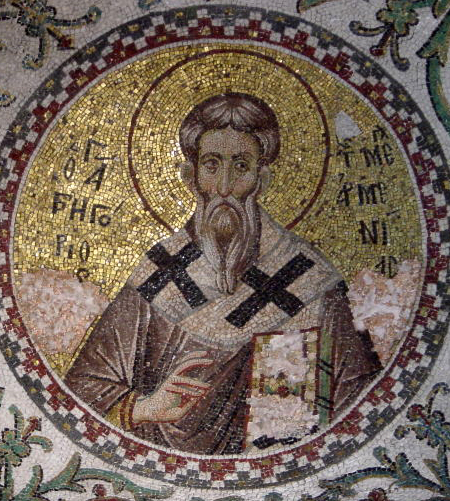I started to type directly from Randel Helms’ Gospel Fictions for this blog (as there’s no online PDF) on May of 2012 and finally finished yesterday my excerpts of it. The excerpted series can now be read from the beginning at my Ex Libris page (here).
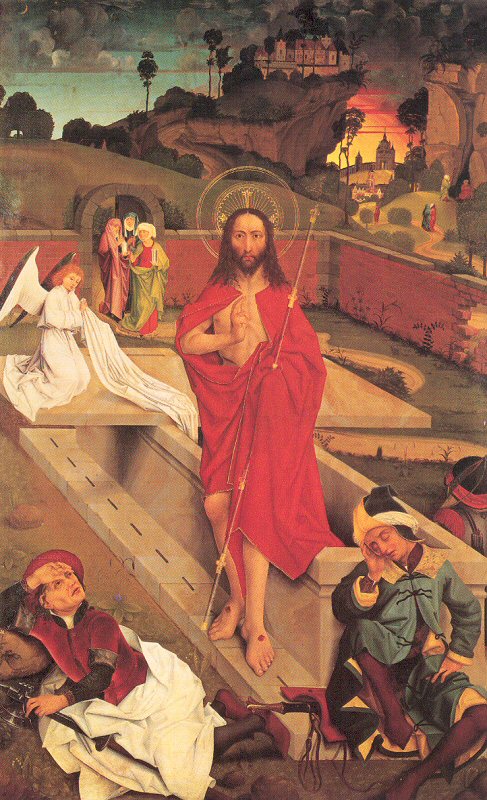 Don’t miss the 7th chapter, ‘Resurrection fictions’. The resurrection stories are even more plagued with internal contradictions among the evangelists than the stories about the crucifixion.
Don’t miss the 7th chapter, ‘Resurrection fictions’. The resurrection stories are even more plagued with internal contradictions among the evangelists than the stories about the crucifixion.
I hope those who are still struggling with the religion of our parents will see it’s not possible to ascertain who the ‘historical Jesus’ was, if such a character existed.
Author: C .T.
Editor’s note: After reading the stories of the white race of Pierce and Kemp, it is obvious that, once the ‘Aryan problem’ is understood, the most practical thing is to exterminate the conquered non-whites instead of using them.
The Aryan problem consists of seeing as capital (slaves) a lower species of humans whose biology allows them to de-code the Aryan DNA and produce fertile mongrels if crossbreeding with them. Since sexual lust is natural among whites, this was precisely how the Roman Empire declined and fell.
In this section we see what Deschner says about the son of Constantine who inherited the empire. Like his father, he forbade Jews from any activity involving slaves: ‘That’s when the Jews’ dedication to financial activities began’. The Christian Constantius practised scorched-earth policies against his Germanic neighbours but not against the Semites at home! In our days the Jewish dominion of the financial sector has its roots in the non-exterminationist, misconceived policies of the Roman emperors. Deschner wrote:
______ 卐 ______
Constantius and his Christian-style government
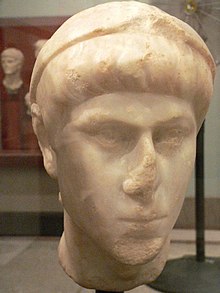 (Bust of Constantius II.) Not content with these perfidious massacres, the ‘religiosissimus imperator’ undertook continuous wars against the Alamanni, the Sarmatians, the Persians and other nations; always very cautious, slow but conscientious, always preparing the campaigns thoroughly, from Mesopotamia to the Rhine. He used to leave only a scorched earth behind him.
(Bust of Constantius II.) Not content with these perfidious massacres, the ‘religiosissimus imperator’ undertook continuous wars against the Alamanni, the Sarmatians, the Persians and other nations; always very cautious, slow but conscientious, always preparing the campaigns thoroughly, from Mesopotamia to the Rhine. He used to leave only a scorched earth behind him.
That politician of whispering and cabinet, in whose court an extraordinary accumulation of bishops met, had very intimate relations with religion. ‘The first ruler who considered himself enthroned by the grace of God’ (Seeck), and who liked to be called officially lord of the whole earth and ‘my eternity’ (aeternitatem meam), was convinced of being an instrument appointed by the Most High and enjoyed the special protection of an angel, whose vague and vaporous contours he even thought he saw sometimes, floating in the air. He practiced chastity with more conviction than his brother, the fan of the ephebes.
This emperor favoured the Christian priests even more than his father, and confirmed, enlarged and multiplied the privileges granted.
If Constantine had dispensed them from the artisanal contribution, Constantius forgave them the territorial contribution and the tax for the use of mail. In the year 355, he ordered that the bishops could not be tried by the common courts, ‘to avoid false testimonies promoted by the fanatical spirits’. And not only did he exempt them from common services, but their wives and children as well as their servants of both sexes would be exempt in perpetuity from all kinds of taxes and benefits on behalf of the State. However, and this is typical of all ecclesiastical history, such concessions only served to make the clergy claim even more privileges.
Constantius, who was not baptized until the end of his life, as his father had done (and in that case, too, being the Arian officiant Eudocium of Antioch), was an Arian Christian. Father Athanasius, his main adversary, includes him in the large list of great Biblical sinners: he calls him perjurer, unjust, irresponsible and worse than the pagan emperors, leader of the impious, accomplice of bandits and Antichrist. ‘There is hardly room for insults worse than those lavished by Athanasius’ (Hagel).
Like his father, Constantius used Christianity as an instrument of his politics and not the other way around. Therefore, as soon as he saw himself as the sole emperor, his first concern was the unity of the Church, although unlike his father, he preferred to look for it in the Arian patriarchs. Hence he banished one after another of numerous Catholic patriarchs, including Athanasius, Paul of Constantinople and Hilary de Poitiers.
Others, like Pope Liberius and Hosius of Corduba, suffered the weight of his authority: ‘My will must be law for the Church’, he explained to those gathered in Milan in 355. ‘You will obey, or you will be banished’. At the same time persecution continued against the Donatists of Africa that Constantine did not initiate, and even proceeded against a sect of Arianism, that of the Anomoeans, seventy of whose bishops are said to have been exiled by his order.
With the Jews, Constantius was even more brutal than his father. A law of the year 339, which calls them a ‘nefarious sect’ and calls ‘markets’ their places of assembly, prohibits under pain of death at the stake to make it difficult for any Jew to pretend to convert to Christianity.
Now, even if the Jews were authorized to become Christians, the Christian who converted to Judaism faced the ‘deserved punishment’, according to the emperor, of confiscation of all his property. He forbade marriages between Christians and Jews; in particular, he persecuted the entry of women into the Hebrew communities with the death penalty.
The Jews could not buy slaves, even if they were pagans, under penalty of confiscation of property, or death penalty if they dared to circumcise them. Consequently, he forbade them any economic activity whose exploitation necessitated the employment of slaves; surely, that’s when the Jews’ dedication to financial activities began, which made them even more hated. The repression was severe, especially with the Jews of Palestine, after an insurrection that was bloody crushed.
The attitude of Constantius against the pagans was also very hard, probably instigated by the Christian party.
Gospel Fictions, 6
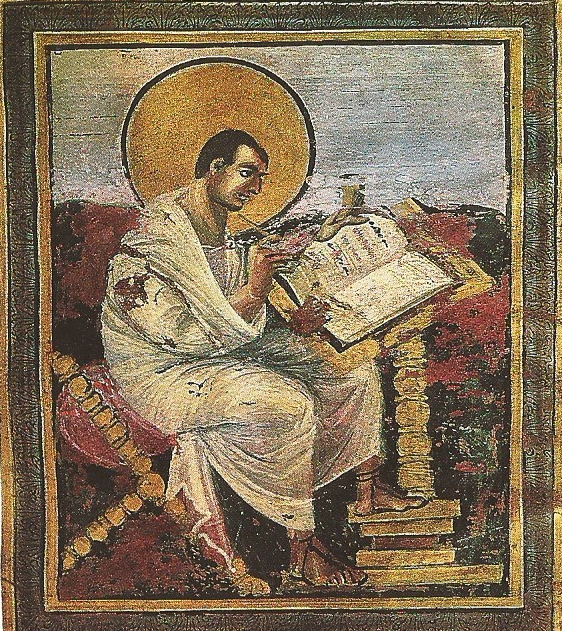
Below, part of Gospel Fictions’ sixth chapter, “The Passion narratives” by Randel Helms (ellipsis omitted between unquoted passages):
The story of the garden of Gethsemane is one of the most moving fictional creations in the New Testament. Though Mark’s Gospel is the first to tell the story in written form, its origins in the Old Testament are more clearly revealed in Luke’s version, whose vocabulary betrays its origins in Septuagint III Kings 19, the story of Elijah’s fleeing from Ahab and Jezebel.
The account is obviously fictional, since there could have been no witness to Jesus’ agony in the garden after he left his followers; they were all, according to the story, asleep.
Judas’ suicide
Mark had said nothing about the fate of Judas Iscariot after Jesus’ arrest, only that the priests promised to pay him money, not even indicating whether the money was ever paid. But the Christian sense of retribution could not rest with this, and soon legends were circulating that Judas died horribly. Luke knew one of these legends:
This Judas, be it noted, after buying a plot with the price of his villainy, fell forward on the ground, and burst open, so that his entrails poured out. This became known to everyone in Jerusalem, and they named the property in their own language Akeldama, which means “Blood Acre.” (Acts 1:18:19)
[Matthew on the other hand wrote:]
So Judas threw the money down in the temple and left them, and went and hanged himself. (Matt. 27:5)
That there were two such legends also accounts for the two different stories about Judas’ death: he hangs himself in Matthew and burst open in Acts. Both versions of the death are based on oracular readings of the Old Testament.
The Crucifixion
That Jesus was crucified by the Romans—the usual method of executing rebels—is the historical basis of the Gospel accounts of Jesus’ death (Mark 15, Matt. 27, Luke 23, John 19); the accounts are nevertheless fiction, composed for theological purposes.
If, as many hold, the author of the Fourth Gospel knew Mark’s work, why did he assert so strongly, contradicting Mark, that Jesus carried his own cross? Again the answer is a matter of theology rather than history. The Fourth Gospel was written, in part, as an attack upon Gnostic Christianity, which held that the Son of God was not really crucified; some Gnostics in fact held that Simon of Cyrene not only carried the cross, but was himself killed upon it. John dealt with that argument simply by eliminating Simon altogether.
Moreover, John had an entirely different picture of Jesus’ condition at the crucifixion. In the Synoptics, the implication is that Jesus is too weak, following his scouring and beating, to carry his own cross; but for John, Jesus is entirely triumphant throughout the passion. John presents no cry of dereliction from the cross (“My God, my God, why hast thou forsaken me?”) but instead insists that the dying words were a cry of triumph: “It is accomplished!” (19:30). Such a figure was quite capable of carrying a cross.
Mark continues: “The hour of the crucifixion was nine in the morning” (the third hour, Roman time—Mark 15:25); John, however, tells us that “It was the eve of Passover, about noon,” when Pilate “handed Jesus over to be crucified.” Thus, we cannot know the hour of crucifixion. Nor, in fact, did the evangelists know: their times were fictional creations, parts of a theological framework.
Below, abridged translation from the first
volume of Karlheinz Deschner’s Kriminalgeschichte
des Christentums (Criminal History of Christianity)
First wars among devout Christians
After the massacre, the sons of Constantine shared the spoils. The eldest, Constantine II (337-340) stayed with the western provinces, Gaul, Hispania, Britannia, and established his residence in Trier; the youngest, Constans, the centrals, Italy, Africa and Greece, with its capital in Sirmium (the current Mitrovicz, in Serbia). Constantius II (337-361), who survived and inherited them all, was awarded East and resided in Antioch until 350, when he was not campaigning.
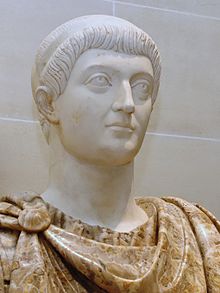 (Bust of Constans)
(Bust of Constans)
Soon war broke out between the eldest and the youngest on a question of border demarcation. In early 340, Constantine II left Gaul and invaded Italy by surprise, but fell into an ambush near Aquileia, while trying to force an alpine pass. Constans’ generals killed him and threw the corpse into the river. In those moments Constantius II, as we will see in the following section, was very busy with the quarrels between Christians and especially with the incursions of the Persians in the East, so that Constans could stay with the western provinces without any discussion.
That seventeen-year-old adolescent, owner of two thirds of the immense empire, was the only one baptized among the sons of Constantine and had been educated in chastity, the ultimate Christian virtue, as we know. In fact, he shied away from women but used to enjoy the company of blond Germans, hostages or slaves, with whom he went out to hunt in remote solitary forests, while publicly declaring himself an enemy of pederasty.
Within the domains of Constans the first temple destructions, sporadic at the beginning, are produced in Rome, as well as a renewed persecution against the Donatists. As they did not allow themselves to be corrupted by the monies of the emperor, which the old Donatus had brusquely rejected, Constans decided to expropriate the unbowed clerics and, by force of arms, handed over the Donatist churches to the Catholics.
In 347 there was the bloody crushing of the Bagai insurrection, where the ordinary was assassinated, another Donatus and Bishop Majorinus, principal saint of the Donatists. Others were tied to columns and whipped by order of Macarius, the imperial commissioner, praised by Catholics as ‘advocate of the holy cause’. They began to speak of ‘the Macarian persecution’. Some Donatists died tortured in prisons. Many fled and others were exiled. Donatus himself died, apparently in the wreck of the ship where he was travelling deported. The assets of the exiles were confiscated.
Meanwhile, on January 18, 350, there was in Autun (Lyon) the pronouncement of General Magnentius, born in Amiens and the son of a Frankish and a Breton, who seized the western provinces. According to some later sources he was pagan; however, the coins he minted suggest the opposite, that is, he was a Christian. The Franks and the Saxons supported him at once, and all the towns and fortresses of the Rhine fell into his hands. Britain, Gaul, Italy, and Africa hastened to recognize him as emperor.
Certainly, Magnentius, the first Germanic anti-caesar and the most dangerous of all the usurpers who threatened the throne of Constantius (up to six in all), failed to enjoy his victory for a long time. The emperor left the Balkans for the Danube, to initiate the ‘holy war’, with troops that doubled those of his opponent. According to Theodoret, even the pagans of the army had to be baptized by order of Constantius.
Magnentius was expelled from Italy in 352; was also defeated in Gaul, and on August of 353, seeing himself surrounded in his castle of Lyon, he threw himself on the tip of his own sword, not without having finished with his intimate friends before; his brother Desiderius and his mother. Constantius had the enemy’s head roved around the country, and had many others cut off.
Poland & Andreas Donner
 I am relocating the below entry I had posted at midnight to noon because I’ve just learnt that this is the group that organised the big nationalist march in Poland—something that destroys the effete discussion about ‘optics’ on this side of the Atlantic. Pace Anglin et al, what whites need is this imagery, not American flags!
I am relocating the below entry I had posted at midnight to noon because I’ve just learnt that this is the group that organised the big nationalist march in Poland—something that destroys the effete discussion about ‘optics’ on this side of the Atlantic. Pace Anglin et al, what whites need is this imagery, not American flags!
This is the text I had originally posted at midnight:
I’ve just listened the interview in Radio Free Northwest of Andreas Donner: very critical of the Alt-Right and White Nationalism as these are a reactionary, not a revolutionary movement.
Tactically the Northwest Front men are right. But strategically I still think that the goal is the hostile takeover of all US à la Turner Diaries, especially its atomic bombs. Otherwise we would be nuked…
Below, abridged translation from the first
volume of Karlheinz Deschner’s Kriminalgeschichte
des Christentums (Criminal History of Christianity)
______ 卐 ______
Chapter 7: The Christian Sons of
Constantine and His Successors
‘Since Constantine, the emperors were much more devoted Christians than they had ever been as pagans’.
— Frank Thiess
‘During the 4th and 5th centuries, the alliance between Christianity and the Imperium Romanum provided the inhabitants of the empire… an entirely new image of the world’.
— Denys Hay
Everything seemed very promising: a new idea of the world, the Imperium as a Christian institution oriented towards peace, the emperors turned into zealous Christians…
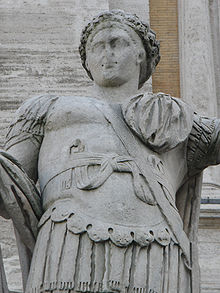 Statue of Emperor Constantine II.
Statue of Emperor Constantine II.
Indeed, the sons of Constantine, Constantine II, Constantius II and Constans, along with the father, were compared by Eusebius with the Trinity. Almost since they began to walk, they were accompanied by experienced prefects, dressed in purple, in the ranks of the army. They were barely fifteen, twelve, eleven years old, and they took part in campaigns on remote fronts. Good Christians and intrepid soldiers: an ideal combination advocated for centuries by a religion of peace that has never brought peace anywhere.
The first Christian dynasty founded on family extermination
The imperial father did the pioneering work. Scarcely had he died and Constantius II, who considered himself an envoy of God and ‘bishop of bishops’, and once even practiced sexual continence, began in August 337 the extermination of almost all the male members of the imperial house in Constantinople: his uncle Dalmatius, half brother of Constantine who had lived many years surrounded by spies, and the father of Emperor Julian, Julius Constance, very hated by the Empress St. Elena, amen of six cousins and other badly seen courtesan personalities. Among these, the almost omnipotent Ablabius, prefect of the praetorians, whose daughter Olympias was promised as a child to Constantine. (Later, Constantius married her to the king of the Armenians, Arsaces III, and she was killed by the former wife of the sovereign with the complicity of a priest who mixed poison in the wine of mass.)
Christian mercy only respected Julian, who was five years old (he would be assassinated during a campaign against the Persians); his stepbrother Gallus was also saved because he was so sick that he seemed lost anyway (he would die in Istria in 354).
Constantius was a Christian, so were most of his obedient assassins, soldiers of his guard; Julian deduced from all this that ‘there is no beast as dangerous to man as Christians are to their fellow-believers’.
And just as no man in the Church had criticised the murders of relatives perpetrated by Constantine, no one censured those of the devotee Constantius, ‘one of the most notorious Christian princes of the century’ (Aland). Eusebius alludes to the ‘inspiration from above’ to justify the carnage. In Constantius one could contemplate a revived Constantine, the bishop wrote, and he was not mistaken. The praises dedicated to the multiple parricide and bellicose Constantius are almost as dithyrambic as those deserved by the military leader and exterminator of relatives, Constantine.
Paradigm of the cruelty according to Amianus, Constantius did not take long in sending a message to the bishop Eusebius of Nicomedia, the preceptor of Julian, asking him never to speak with him about the destinies of his family.
And six years later, Julian and Gallus were imprisoned in Macellum, a sinister fortress hidden between mountains— ‘without authorizing anyone to approach us, without studies worthy of such a name, without conversations, although we were surrounded by a splendid service’, remembers Julian. A secret agent of the emperor suggested Gallus, the first-born, that Constantius was not guilty of the death of his father, and that the extermination of his family had been an uncontrolled act of the soldiery.
Julian, 17
Julian presiding at a conference of Sectarians
(Edward Armitage, 1875)
Gallus made a good impression on everyone—somewhat to my surprise, for he was always rather sullen with Bishop George and downright cruel to me and his teachers. But set among the great officers of the state, he was a different person. He laughed; he flattered; he charmed. He was a natural courtier, and one by one he enchanted the members of the Sacred Consistory, as the Emperor’s council is known. Only with Constantius did he make no headway. Our cousin was biding his time.
During the time the court was at Macellum, the junior officers and lesser officials dined in the main hall of the palace, while the Emperor and the magnates dined in the banqueting hall, which was somewhat smaller. In the hour before dinner everyone used to gather in the main hall to gossip. It was our first experience of a court. I found it bewildering, but Gallus took to it like a swan to water.
One evening Gallus allowed me to tag after him as he moved through that splendid company. Gallus was an excellent politician. He made friends not just with the magnates but also with the clerks and notaries who do the actual work of governing. He was shrewd. I of course was perfectly tongue-tied.
In the large hall, Gallus quickly gravitated to the group of officers with whom he had only that day gone hunting. I remember looking at these young men with wonder, for they had actually killed other men in battle in such far-away places as Germany and Mesopotamia. They were unusually self-contained and rather quiet, unlike the clerks and notaries, who were exceedingly talkative, eager to impress one with their knowledge of secret matters.
Gallus seemed particularly to like one tribune, an officer in his thirties named Victor (who is now one of my generals). Victor was—is—an impressive-looking man who speaks good Greek, though he comes from the Black Sea; he is bandy-legged and pale-eyed like so many Russians. “Is this the most noble Julian?” he asked, turning to me.
Gallus introduced me in an offhand way to the company. I blushed and said nothing.
“Will you be serving with us in the household troops?” Victor asked.
Gallus answered for me. “No. He’s going to be a priest.”
Before I could deny this, Victor said quite seriously, “I can think of no life worthier than one in the service of God.” I was struck by the simplicity with which he said this. No irony was intended.
Gallus was somewhat taken aback. “Not for me,” he said finally.
“Nor for me, unfortunately.” Victor gave me a sympathetic smile. “You must pray for us,” he said.
Gallus changed the subject. While he talked hunting with Victor, I stood by silently, beginning to feel already like one of those Galilean monks or “solitaries” as they are called, which is rather a misnomer since no monk is ever solitary. They are the most gregarious set of men in the world, for ever eating, guzzling and gossiping with one another. Most of them retire from the world in order to have a continuous party.
“Are you really going to become a priest?” The voice was low. I turned and saw a young man standing behind me. He had obviously been there for some time. I shook my head. “No,” I said.
“Good.” He smiled. He had sharp grey eyes beneath brows which met, giving him the look of one continually concentrating on some distant object. He wore civilian clothes, which was odd since at his age anyone of good family wears uniform at court.
“Who are you?” I asked.
“Oribasius of Pergamon, physician to the divine Augustus, who doesn’t need me. Your cousin is the healthiest man I’ve ever met.”
“I am happy to hear that!” I blazed sincerity. One’s neck depended on this sort of response.
“It’s a matter of diet,” said Oribasius matter-of-factly. “He’s a perfect example of the moderate life. He drinks almost no wine. He never overeats. He’ll live forever.”
“I pray that he does,” I said, my heart sinking. What would my life be like, lived in the shadow of a never-dying, always suspicious Constantius?
“But why does your brother say you’re going to be a priest?”
“Because I read books. He finds that strange.”
“And he associates strangeness with the priesthood?”
I tried not to smile. “Something like that. But I should like to be a philosopher or a rhetorician. Apparently I have no gift for soldiering. At least Gallus says I haven’t. But then, everything depends on the will of the divine Augustus.”
“Yes,” said Oribasius. He looked at me curiously. I recognized the look. I had seen it all my life. It meant: Are they going to kill this boy? And if they do, how interesting it all is! From birth I had been treated like a character in a tragic play.
“Do you like Macellum?”
“Would you, if you were me?” I had not meant to say this. But his look had irritated me and I suddenly rebelled at being treated like a mere thing, a victim, the dumb sacrifice in a bloody legend.
“No,” said Oribasius evenly. “I would not.”
“Well, then, you know how it is.” But frightened now that I had said too much, I began to babble about the goodness of my cousin, the kindness of Bishop George, the beauty of Cappadocia. For all I knew, Oribasius was a secret agent. Luckily, one of the chamberlains came to announce the approach of the Emperor, and I hurriedly left the main hall and took my place at table.
I have recorded this meeting with Oribasius, since he was to become my closest friend. But I did not see him again at Macellum or, if I did, I don’t remember him. He has told me since, “I’ve never seen anyone look so frightened as you.”
When I told him that my memory of myself in those days was one of serene self-control, Oribasius laughed. “I was positive you were on the verge of madness. I even diagnosed you—incorrectly—as an epileptic.”
“And what did you think of Gallus?”
“He was the one who appeared serene. I was quite impressed.”
“And of course Gallus went mad.”
“I don’t claim to be infallible.”
People never make the impression they think they make. But Oribasius was quite right in one thing: I was terrified.
Below, abridged translation from the first
volume of Karlheinz Deschner’s Kriminalgeschichte
des Christentums (Criminal History of Christianity)
______ 卐 ______
Chapter 6: Persia, Armenia and Christianity
‘The origin and founding of that Church are typically Armenian. Gregory [the apostle of Armenia] violently crosses the country, surrounded by troops, destroys the temples and goes Christianizing the population. It was something never seen before in the Hellenic world’.
— G. Klinge
‘The Armenians put to the knife all the Persian army, without sparing a single life’, ‘they did not leave man or woman alive’. ‘They saw the bloodbath perpetrated among the defeated troops. The whole region reeked of the stench of corpses… That is how Saint Gregory was avenged’.
‘Console yourselves in Christ, because those who died did so first of all by the country, by the church and by the grace of the divine religion’.
—Wrthanes, Patriarch of Armenia
Mosaic icon of St. Gregory the Illuminator
(Pammakaristos Church, Istanbul)
Saint Gregory destroys Armenian paganism and founds a hereditary patriarchy
The conversion of Armenia was the work of Gregory the Illuminator, the apostle of the Armenians. Converso to the Christianity of Caesarea, he began to preach the new religion towards the year 280, when Tiridates re-conquered Armenia. He had great ascendancy over Khosrovidukht, a sister of the king, thanks to which he ended up enjoying the favouritism of the sovereign: a very characteristic process, since we know that the clergy have always used women, sisters, wives or beloved of the princes to dominate them. By this procedure the ‘Christianization’ of entire nations was achieved.
Persuaded by his sister, King Tiridates finally sent a delegation headed by Gregory to Caesarea. Once there, the ordinary Leontius made him bishop and spiritual head of the Armenian Church. Shortly after Tiridates and his wife Ashkhen were converted, they promulgated an edict by which all the subjects (as Sozomen, historian of the Church, recounts) were forced to embrace the religion of the monarch. It is the first proclamation of Christianity as the official religion, although from the 4th century the exact date of the disposition is subject to controversy, mainly because almost all the ecclesiastical chroniclers of the period silenced the case systematically.
As strange as that may seem, and while the date is still being discussed, the fact remains that the proclamation of Christianity as the official religion of Armenia initiates a period of tremendous persecutions against paganism.
Backed and protected by the king, Gregory devoted himself to thoroughly destroying the temples to replace them with Christian churches, which were also endowed with generosity. In Artaxata, which had been a prominent centre of polytheism, ‘the wonderful Gregory’ (as Faustus of Byzantium called him) razed the temple of Vahagn (Hercules), that of Astiik (Venus) and that of Anahit; then he built a splendid Christian church destined to be the new ‘national sanctuary’ of Armenia.
At the same time, Gregory had a palace built for his own use. He was named archbishop, first dignitary of the kingdom after the king and katholikos. This title, also adopted by the archbishops of Persia, Ethiopia, Iberia and Albania, was very significant, since formerly it was the one that corresponded to a high official of the public treasury. Gregory the illuminator, revered as a saint by the Armenian Church and also included in the Roman martyrology by Pope Gregory XVI (his dedication is celebrated on September 30), did not fail to attend to his own needs and those of his own, using the properties of the Church for personal benefit and of their relatives.
The Byzantine writer Faustus, author of the grandiloquent history of Armenia in the year 400, devotes dozens of chapters to the successive slaughters that totalled 29 victories over thirty-four years, if we are to believe what this Christian author says (of quite debatable veracity)…
Although the Christians fought in numerical inferiority from one to ten, or even from one to a hundred, they always exterminated their enemies, women and children included. In 1978, a remarkable dignitary of the Armenian Apostolic Church, Mesrob Krikorian, echoes those dithyrambs: ‘In any case, the Christian religion assumed paramount importance for Armenia and for all Armenians of the time’. Faustus emphasizes again and again that ‘all the Persian soldiers were put to the sword by the Christian troops, not sparing one of them’, ‘not even the women of the entourage’, ‘not one escaped alive’,’ they did a general bloodbath’.
A new and beautiful face!
The reading of these chronicles vividly recalls the Old Testament and the massacres and raids of the Israelites. ‘The Armenians made an incursion through the Persian provinces’, ‘they returned loaded with treasures, weapons, jewels and great booty, covering themselves with imperishable glory and enriching themselves inappropriately’, ‘the country was passed over fire and iron’. On occasion, they also fought against Christian Rome, allied or not with the pagan Persians (and with no less success, as is already understood).
Thus, for example, according to Faustus, ‘for six years in a row they devastated the Greek provinces’,’ they put all the Greeks to the sword in such a way that not a single one was spared’, and ‘there is no measure or account of the treasures they brought with them…’ Always, naturally, fighting under the banners of God, trusting in God, overcoming in the name of God; it is God who grants ‘the fate of great victories’.
The clergy and war… united in the first Christian state in the world. Heroic actions ‘by Christ Our Lord’. Undoubtedly, the Armenians did not need the ecclesiastical blessing to start fighting and killing. But the fact is that the blessing was not lacking.
Linder reads 'Hunter'

Alex Linder reads Pierce’s Hunter in five sessions. If you have not read the novel you might consider listening to it. The dialogues between the novel’s two main characters are incredibly perceptive as to the whys of white decline. Linder of course reads it in English (this pic is from the German translation of the book).
Editor’s note: The author states below: ‘This provision [by Constantine] had serious consequences, as it was one of the first to deprive Jews, in practice, of owning farms’. This is how the first seeds were planted for the Jews to do what today is called ‘white collar’ jobs.
In the days of Ancient Rome the Jews still did not have an IQ superior to Whites. This policy of cornering Jews to work outside of what is now called ‘blue collar’ jobs continued until the French Revolution. Although the anti-Semitic seed of Constantine described below could be applauded by white nationalists, seeing it in perspective was a shot that backfired.
Parallel to allowing Jews in banking and usury, throughout the Middle Ages the best genes of White intellectuals ended, excuse me the crude expression, in the asses of the novices of the monasteries instead of in the fair sex. Unlike the Christians, medieval Jews never practised vows of celibacy. The artificial selection of genes that raised the IQ of the Jews at the expense of the lack of descendants of intelligent Whites (Aryan monks) was a courtesy of Christendom.
In previous chapters the author constantly used quotation marks around the word ‘pagans’. In this chapter he removed the quotation marks. Since ‘pagan’ was Christian newspeak of the 4th century, in some instances of this entry I’ll take the liberty to substitute the textual ‘pagan’ for something like ‘adepts of Greco-Roman culture’.
Below, abridged translation from the first volume of Karlheinz Deschner’s Kriminalgeschichte des Christentums (Criminal History of Christianity):
______ 卐 ______
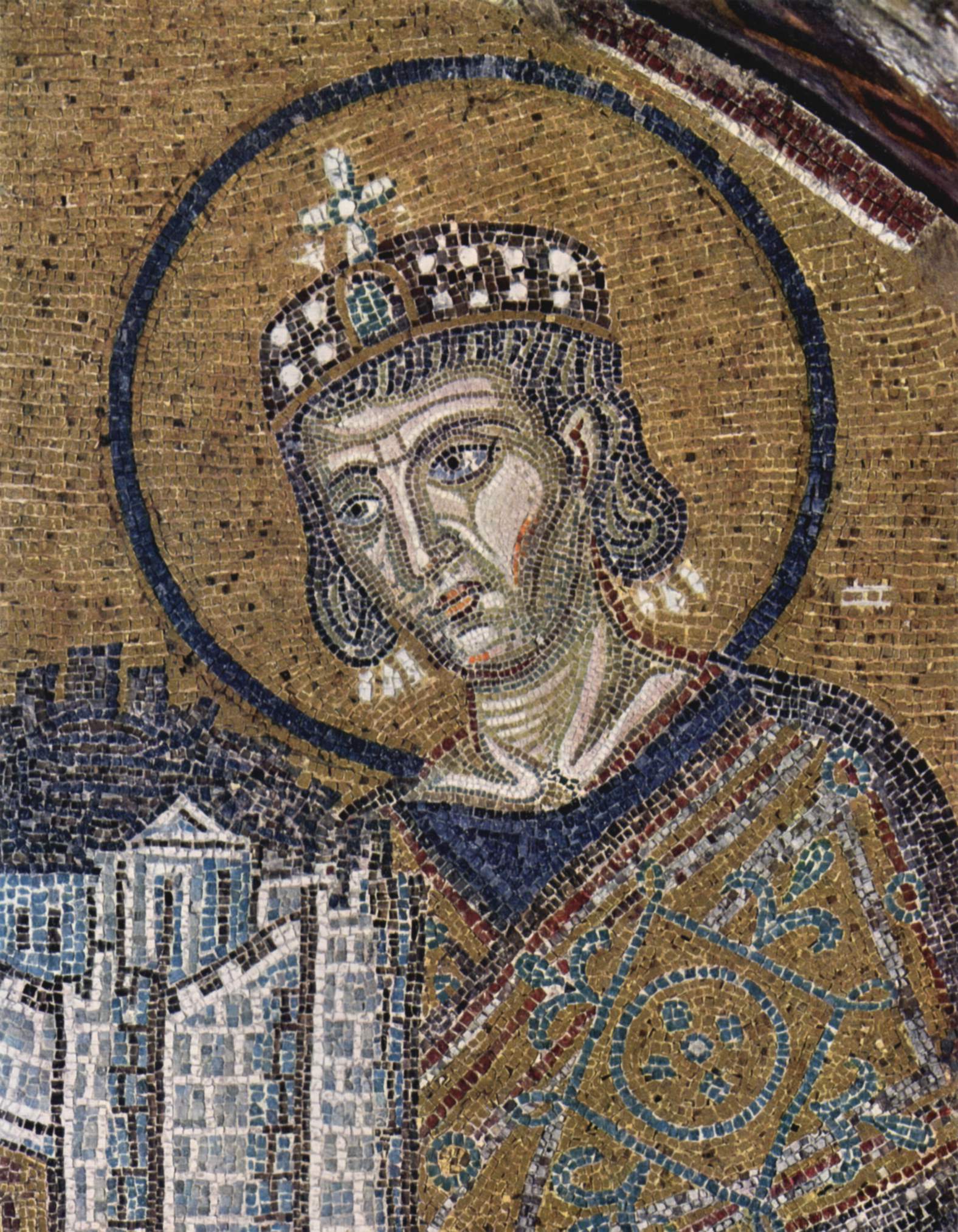 Constantine against Jews, ‘heretics’ and pagans
Constantine against Jews, ‘heretics’ and pagans
The emperor was not very friendly with the Jews, surely he was greatly influenced by the permanent anti-Semitic attacks of the doctors of the Church, which we have seen in chapter 2, and the recent Synod of Elvira, which had sanctioned with very strong penances the relations between Christians and Jews, in particular the attendance to blessings of fields and banquets celebrated by Jews.
The Roman emperors were quite tolerant of Judaism; not even Diocletian tried to force them to comply with the pagan rites. But after the Council of Nicaea Constantine comes to the conclusion, reflected in an epistle to all the communities, that the Jews ‘tainted by delirium’, ‘wounded by the blindness of the spirit’, ‘deprived of the right judgment’, are ‘an odious nation’ and except for one day a year forbids them to set foot on the city of Jerusalem that he and his mother had filled with churches.
In addition, he forbade them to have slaves like Christians. This provision had serious consequences, as it was one of the first to deprive Jews, in practice, of owning farms. The Christian who Judaized was sentenced to death. In addition, Constantine renewed a law of Trajan, promulgated two hundred years before, according to which the pagan who was converted to Judaism was condemned to the stake.
Even harder was the policy against the ‘heretics’, and this already from the time of the regency, from the year 311, on the grounds that many of those who had abjured Christianity wanted to receive baptism again. This resulted in a schism with bloody repercussions that lasted for several centuries. It is at that time when the definition of ‘catholic’ as opposed to the figure of the ‘heretic’ appears for the first time in an imperial document.
The Donatists rejected the association with the State, the Constantinian alliance between the throne and the altar. They judged that they were the true Ecclesia sanctorum and that the Roman Church was the civitas diaboli. They appealed to the Christian’s beliefs by demanding greater austerity for the clergy. Constantine’s campaign against Licinius turned against the Donatists at the instigation of Bishop Caecilianus in a campaign that lasted several years, presided over by the decision to ‘not tolerate even the slightest hint of division or disunity, wherever it may be’. Moreover, in a letter from early 316 to Celsus, vicar of Africa, Constantine threatened: ‘I intend to destroy the errors and repress all the nonsense, in order and effect to offer to all the human race the only true religion, the only justice and unanimity in the worship of the almighty Lord’.
To the Donatists he took away their churches and their fortunes, exiled their chiefs and commanded troops who slaughtered men and women. The hecatomb of the adepts of Hellenism had not yet begun and Christians were already making martyrs of other Christians.
Constantine also fought against the Church of Marcion, an older church and at some point probably also more followed than the Catholic Church. Constantine prohibited the offices of the Church of Marcion even when they were held in private homes; had their images and properties confiscated, and ordered the destruction of their temples. His successors, most likely instigated by the bishops, stepped up the persecution of this Christian sect after having defamed it and by all means, including through falsifications during the 2nd and 3rd centuries. In 326, shortly after the Council of Nicaea, Constantine issued a scathing edict ‘against heretics of every kind’, in case it was authentic of course and not a figment of Eusebius.
Constantine’s actions against the ‘heretics’ set an example, but at least he respected life most of the time. After all, he did not care about religion as much as the unity of the Church on the basis of the Nicaea Council, and hence the unity of the empire. Undoubtedly, he had an exclusively political concept of religion, although religious problems always, and from the first moment, were presented in relation to social and political conflicts. In the interest of state power he promoted the unity of the Church. This, and not another, was the cause of his hatred of all kinds of discord. ‘I was sure that, if I could complete my purpose of uniting all the servants of God, I would reap abundant fruits in the public interest’, he wrote in a letter to Arius and Bishop Alexander.
In the year 330, Constantine sends a sentence against the Neo-Platonic school and even orders the execution of Sopater, who had been presiding over this school since the death of Iamblichus. The adepts of Hellenism become ‘fools’, ‘people without morals’ and their religion a ‘hotbed of discord’. Constantine’s true intention was that all humans ‘revered the one true God’ and that they forsake ‘the temples of the lie’.
While the adepts of Hellenism of the western provinces still enjoyed relative tranquillity, in the East the persecutions began after the definitive defeat of Licinius (324). Constantine forbade the erection of new statues to the gods, the worship of existing ones, and the consultation of oracles and all other forms of Greco-Roman worship.
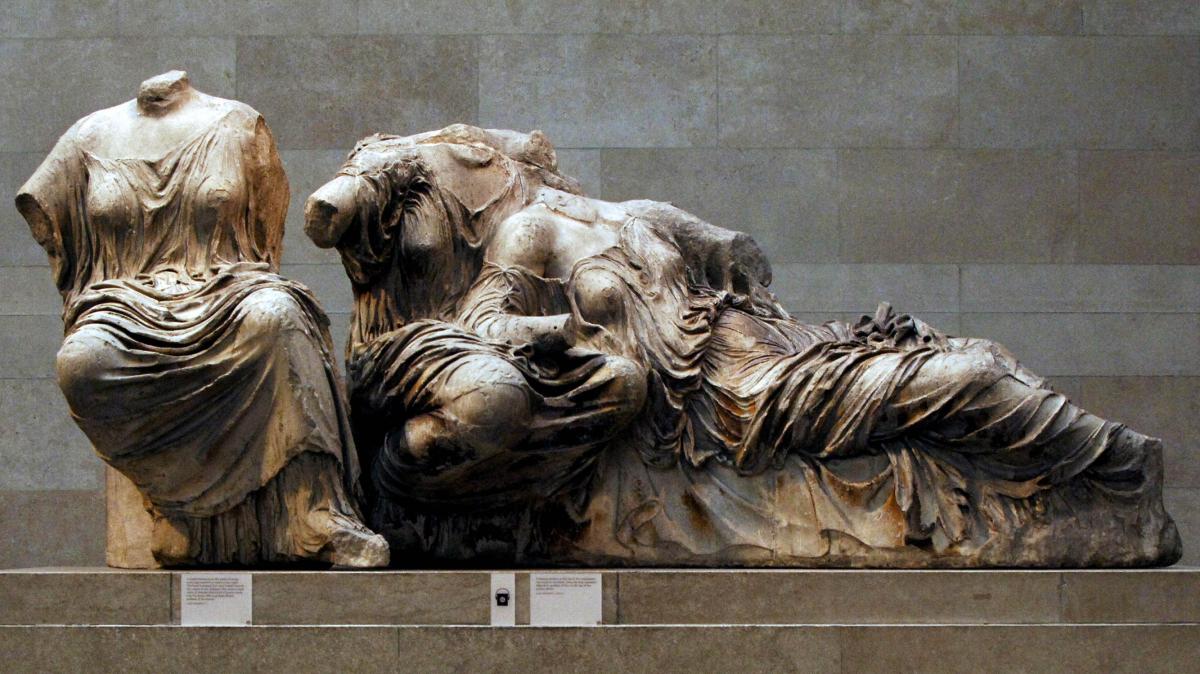
In 326 Constantine came to order the destruction of all the images, while in the East he began the confiscation of temple properties and the plundering of valuable works of art. In his new capital, blessed on May 11, 330 after six years of work funded in part through the treasures confiscated from the temples, Constantine banned the worship and the festivals of the adepts of Hellenism and rents were no longer paid to the temples of Helios, Artemis Selene and Aphrodite.
Constantine, described as a ‘renegade’ and ‘innovator and destroyer of ancient and venerable constitutions’ by Emperor Julian, but praised by many modern historians, soon prohibited the repair of Greco-Roman temples and ordered numerous closures and destructions ‘directed precisely against those who had been most revered by the idolaters’ (Eusebius). He arranged the closing of the Serapis of Alexandria, the temple to the Sun-God in Heliopolis, the demolition of the altar of Mamre (because the Lord himself had appeared there to Father Abraham, in the company of two angels), and that of the temple of Aesculapius in Aegae, the latter being fulfilled with such diligence ‘that not even the foundations of the ancient ravings remained’ (Eusebius).
Constantine also ordered the destruction of the temple of Aphrodite on Golgotha, for the ‘great scandal’ that it represented for the believers; it was also the turn of Aphaea in Lebanon from whose sanctuary came ‘a dangerous web to hunt souls’ and which, according to the emperor, ‘does not deserve the sun to shine’. There was no stone left upon a stone; and the very famous Heliopolis was burned down and reduced to rubble by a military command.
Constantine burned Porphyry’s controversial writings. From the year 330, when Neo-Platonism was forbidden, Christians abounded in looting of temples and breaking images, as all Christian chroniclers celebrated and despite such activities having been implicitly prohibited by the Council of Elvira.
Contrary to what Christian historians would like us to believe, the emperor, naturally, was not interested in fighting face to face with the Greco-Roman culture that still held the majority in much of the empire and retained part of its strength, which of course does not mean that there were not well received ‘the small material expropriations’ (Voelkl): the stones, the doors, the bronze figures, the vessels of gold and silver, the reliefs, ‘the valuable and artistic ivory votive offerings confiscated in all the provinces’, as Eusebius highlights.
‘Everywhere they went stealing, looting and confiscating the images of gold and silver and the bronze statues’ (Tinnefeid). Constantine did not even respect the famous tripods of the fortune-teller of the sanctuary of Apollo at Delphi. The historian Kornemann notes ‘a theft of works of art as has never been seen in all of Greece’.
Even St. Jerome criticized that the city of Constantinople had been built with the booty of almost all other cities. ‘In the blink of an eye, whole temples would disappear’, rejoices Eusebius. The entire Olympus was gathered in the ‘new Rome’, where the emperor, even without daring to tear down the temples, had all the statues removed from them. The most venerated gods were installed in bath-houses, basilicas and public squares. The deified Apollo, which had been the most venerable monument in the Hellenic world, was converted into a Constantine the Great. ‘Immense riches disappeared from the coins or went to fill the empty coffers of the Church’, Voelkl reminds us.
Eusebius tells us that… the temples and sanctuaries, once so proud, were destroyed without anyone ordering it, and churches were built in their place and the old delirium was forgotten.
However, at the Easter of 337 the sovereign fell ill. First he sought remedy in the hot baths of Constantinople, and then in the relics of Lucian, protective patron of Arianism and disciple of Arius himself. Finally he received on his farm, Achyronas of Nicomedia, the waters of baptism despite his desire to take them on the banks of the Jordan in imitation of Our Lord. At that time (and until about 400) it was customary to postpone baptism until the last minute, especially among princes responsible for a thousand battles and death sentences. As Voltaire suggests, ‘they believed they had found the formula to live as criminals and die as saints’. After the baptism, which was administered by another colleague of Lucian named Eusebius, Constantine died on May 22 of the year 337.
While the Christians have almost dispensed with their common sense for praising Constantine, obviously there are very few testimonies of his critics that have reached us, among them those of the Emperor Julian and the historian Zosimus.

